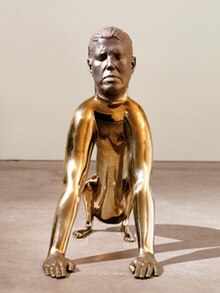| Revision as of 15:08, 11 October 2012 editMalerooster (talk | contribs)Extended confirmed users, Pending changes reviewers18,089 edits copy edit← Previous edit | Revision as of 23:30, 11 October 2012 edit undoQworty (talk | contribs)13,129 edits as admitted on BLPNNext edit → | ||
| Line 1: | Line 1: | ||
| {{multiple issues| | {{multiple issues| | ||
| {{AUTO}} | |||
| {{cleanup-reorganize|date=October 2012}} | {{cleanup-reorganize|date=October 2012}} | ||
| {{copy edit|for=unorthodox formatting|date=October 2012}} | {{copy edit|for=unorthodox formatting|date=October 2012}} | ||
Revision as of 23:30, 11 October 2012
This article has multiple issues. Please help improve it or discuss these issues on the talk page. (Learn how and when to remove these messages)
|
Rona Pondick (born April 18, 1952) is an American sculptor. She lives and works in New York City. Pondick has used the language of the body in her sculpture, both literally and metaphorically, since 1977. The artist’s fascination with materials has been a consistent theme in her work from early on to the present day.
Early work
Her work from the 1990s has been described as expressions of infantile, juvenile, and adult desires.
Writing about Pondick’s teeth sculptures in The New York Times, the critic Michael Brenson said, “These sculptures are like Freudian vaudeville acts designed to make you laugh until you feel something caught in your throat.”
In the mid 1990s, in her first outdoor commissioned sculptures, Pondick began combining the disembodied mouth, a theme from her early work, with trees. These sculptures were cast in aluminum or stainless steel. As the critic Ken Johnson wrote in The New York Times about Pondick’s Tree, “Looking at this eerie yet comical tableau, you feel that Ms. Pondick has tapped into an ancient underground pool of desire, anger and grief. There is something mythic about the scene; it could represent a primeval story about the origins of the world in darkness and light.”
Hybrid sculptures
Her hybrid sculptures have been compared to Goya and Redon, and Pondick’s extensive knowledge of art history has always informed her work. Particular influences include Donatello and Bernini, and Pondick feels affinity with more recent artists including Philip Guston, Louise Bourgeois, and Bruce Nauman.
In 1998, Pondick began melding animal figures with highly detailed parts of her own body. Her animal/human hybrid sculptures are primarily cast in stainless steel or bronze and are sculpted in a way that makes the merged figures seem natural.

Dog, 1998-2001, yellow stainless steel
Dog, 1998-2001, was the first animal/human hybrid made by Pondick. It is often compared to the Sphinx in its stance and form.
In her tree/human hybrid sculptures, Pondick integrates her own head and hands with tree forms evoking bodily feeling and psychological content that writers have related to historical mythological subjects.
Cast in bronze, aluminum, and stainless steel, Pondick’s tree/human hybrid sculptures have been exhibited indoors and outside, on tabletops, amid living trees, and in the center of a pond.While her first tree commission dates back to 1995, it was in 2001 when she made her first tree/human hybrid sculpture. Pussy Willow Tree was commissioned by Fondation pour l’art contemporain Claudine et Jean-Marc Salomon in Annecy, France and is permanently installed on the grounds. “Forever blossoming, Pondick’s steel ‘tree of life’ is a vivid symbol that touches upon a host of creation myths and universal cosmologies.”
In 2003 Pondick made Crimson Queen Maple, another large-scale tree/human hybrid sculpture that was commissioned by Cranbrook Art Museum. “At Cranbrook, people huddled about Pondick’s lustrous tree…One morning a scrap of paper was pierced onto the tip of one of its finely wrought branches with the urgent message: ‘Please tell the artist this is amazing.’”
Working practice
In individual sculptures Pondick often combines hand-modeling, carving, mold-making, metal casting and chasing, with cutting-edge 3D computer technologies, always in pursuit of the metaphorical and psychological. The artist merges methods, techniques, and technologies seamlessly, making it difficult to discern exactly how her sculptures are made.
Pondick has used a wide range of materials, looking for metaphoric meaning in their sensuous properties. The artist has said, “When you look at a Bernini sculpture…you sense that the material is alive. In The Ecstasy of Saint Teresa…you can feel the saint’s orgasm in the marble. ‘It’s about how to make something feel materially so sensuous that you feel it in your body.’”
References
- MacAdam, Barbara A. “Self-Portrait as Muskrat, Monkey, and Mouse,” ARTnews, May 2010, pp. 92-97.
- Koplos, Janet. “Rona Pondick: Orchestrated Obsessions.” Art in America (September 2002), pp. 114-19.
- Brenson, Michael. “Foot and Mouth.” New York Times, May 3, 1991, p. C19.
- Houston, Joe. “The Alchemical Forest.” Rona Pondick: Works / Werke 1986–2008, New York, Salzburg. (Paris/Salzburg: Galerie Thaddaeus Ropac; New York: Sonnabend Gallery, Salzburg: Internationale Sommerakademie für Bildende Kunst, 2008), pp. 89–107.
- Johnson, Ken. “Rona Pondick.” New York Times, October 3, 1997, p. E35.
- Princenthal, Nancy. “A Dreamlike Melding of Human, Beast and Steel.” New York Times, April 7, 2002, pp. 33, 35.
- Stoops, Susan L. “Visceral Meaning: How Sculptors See.” Rona Pondick: The Metamorphosis of an Object (Worcester, Massachusetts: Worcester Art Museum, 2009), pp. 11–27.
- Princenthal, Nancy. “A Dreamlike Melding of Human, Beast and Steel.” New York Times, April 7, 2002, pp. 33, 35.
- Johnson, Ken. “Rona Pondick.” New York Times, October 3, 1997, p. E35.
- MacAdam, Barbara A. “Self-Portrait as Muskrat, Monkey, and Mouse,” ARTnews, May 2010, pp. 92-97.
- Houston, Joe. “The Alchemical Forest.” Rona Pondick: Works / Werke 1986–2008, New York, Salzburg. (Paris/Salzburg: Galerie Thaddaeus Ropac; New York: Sonnabend Gallery, Salzburg: Internationale Sommerakademie für Bildende Kunst, 2008), pp. 89–107.
- Houston, Joe. “The Alchemical Forest.” Rona Pondick: Works / Werke 1986–2008, New York, Salzburg. (Paris/Salzburg: Galerie Thaddaeus Ropac; New York: Sonnabend Gallery, Salzburg: Internationale Sommerakademie für Bildende Kunst, 2008), pp. 89–107.
- MacAdam, Barbara A. “Self-Portrait as Muskrat, Monkey, and Mouse,” ARTnews, May 2010, pp. 92-97